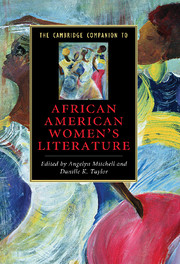Book contents
- Frontmatter
- Introduction
- Part 1 History, contexts, and criticism
- Part II Genre, gender, and race
- 6 African American women and the United States slave narrative
- 7 Autobiography and African American women’s literature
- 8 “Even some fiction might be useful”: African American women novelists
- 9 African American women poets and the power of the word
- 10 African American women in the performing arts
- 11 African American women writers of children’s and young adult literature
- 12 African American women essayists
- 13 African American women writers and the short story
- 14 African American women writers and popular fiction: theorizing black womanhood
- Bibliography
- Index
6 - African American women and the United States slave narrative
from Part II - Genre, gender, and race
Published online by Cambridge University Press: 28 July 2009
- Frontmatter
- Introduction
- Part 1 History, contexts, and criticism
- Part II Genre, gender, and race
- 6 African American women and the United States slave narrative
- 7 Autobiography and African American women’s literature
- 8 “Even some fiction might be useful”: African American women novelists
- 9 African American women poets and the power of the word
- 10 African American women in the performing arts
- 11 African American women writers of children’s and young adult literature
- 12 African American women essayists
- 13 African American women writers and the short story
- 14 African American women writers and popular fiction: theorizing black womanhood
- Bibliography
- Index
Summary
Introduction
The origins, development, generic conventions, and major themes of the slave narrative are fundamental to understanding the genre of the slave narrative, a literary genre first seriously studied by Marion Wilson Starling in the 1946 dissertation that became her vast book titled The Slave Narrative. Dictated, shaped, and, in one unique case, written by enslaved and formerly enslaved African American women before the ratification of the Thirteenth Amendment to the United States Constitution and the Reconstruction era that followed, the slave narrative - its complex artistry and aesthetics - continues to inform the literary forms subsequently developed by African American women writers. Studies in the slave narrative have examined the critical and imaginative shifts the genre has made over time. Just as the conventional, often confessional slave narratives of the eighteenth century assume a different form and undertake issues different from those in later autobiographies by African Americans, the antebellum slave narrative differs from its postbellum counterpart in terms of its relationship to national ideals. Furthermore, post-Emancipation narratives differ from post- Reconstruction era narratives, which share relatively few traits with the twentieth-century narratives collected from elderly ex-slaves as part of the Federal Writers Project and the Workers Progress Act in the 1930s and 1940s. The antislavery autobiographies published as books, pamphlets, and serial articles during the early nineteenth century arguably have the most in common with the postmodern neoslave narratives of the late twentieth century and afterward.
- Type
- Chapter
- Information
- The Cambridge Companion to African American Women's Literature , pp. 109 - 127Publisher: Cambridge University PressPrint publication year: 2009
- 2
- Cited by



